November is the last month of spring in New Zealand but there’s no sign of summer around the corner. After four months placement on a dairy farm in Canterbury, I drove five hours south to see another side of New Zealand dairy farming.
I arrived in West Otago in a pair of shorts on 14 October. On 15 October, I ditched the shorts for waterproofs and a rain jacket.
In the past week of bad weather, diversification into water buffalo and water cress farming has been discussed during milking on my new farm while the rain pounded off the tin sheets above our heads.
Combination
When you think about dairy farming in New Zealand, words such as winter milk, pedigree cows and cubicle sheds aren’t the first things that come to mind. It’s a rare combination to find over here but the power of social media helped me out.
Presenting myself as an “Irish dairy student missing the sight of Holsteins” on Twitter, I struck up conversation with Bruce Eade (@fairleigh_ag).
We knew nothing of each other but I soon discovered that Bruce had worked for a tillage farmer in Co Meath and had delivered a trailer load of cattle feed potatoes to my own farm at home back in 2001. It’s a small world!
Before I knew it, I was heading down State Highway 1 to start working on his farm. I realised just how far south I was when Bruce took me to a nearby hill top the first evening after milking and pointed out Invercargill and Bluff (next stop Antarctica).
The system
The farm here is a complete contrast to the Canterbury Plains. The rolling hills of Otago remind me of Nobber and the big milky Holsteins and Ayrshires are a pleasant sight in the paddocks. Ken and Nancy Eade are Bruce’s parents. They bought the farm here in 1995 and converted the 450ac block from a sheep farm to a dairy unit.
Originally, a 30-unit herringbone parlour was installed to milk 300 cows but as the herd and farm grew another 10 units were added to the pit to cope with the current herd of 510 cows.
Ken tells me of how in 1995 the farm produced 72,000kg of milk solids but now produces over 250,000kg of milk solids. One of the secrets to the increase in production on the farm has been accredited to the 520-cow cubicle shed built in 2012.
Housing
Previously dry cows had been grazed on kale over winter. Ken says they always survived the winter but never gained condition or thrived.
Bruce decided something had to change during a snowstorm in spring 2011. He was feeding out silage in a paddock white with snow, the wind picked up and he couldn’t find the gap back out of the paddock in the blizzard conditions.
A month later after looking at a handful of other cow barns, he sent a plan into the local council and ground work started midsummer. Concrete was poured soon after and steel began to arrive.
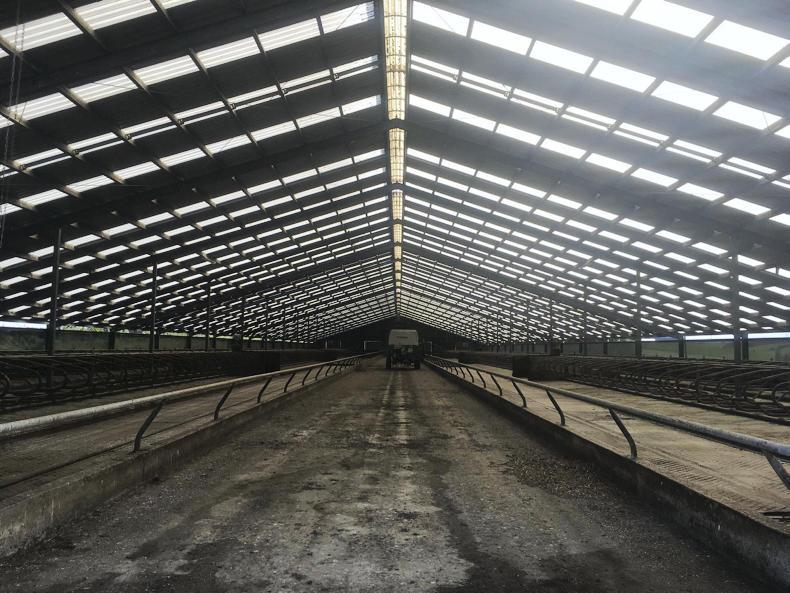
The cow barn which allowed the Eade's to start winter milking.
A 30t crane built all the steel in a day, the roofing was done a week later and the cows moved in on 25 May 2012, only six months after the idea’s conception.
Building the shed allowed the Eades to also begin winter milking. Empty cows no longer had to be culled or carried over dry for a year but instead could be milked on and calved in the autumn to produce winter milk.
In New Zealand, winter milk contracts are paid as a surplus on top of the normal milk price. Winter milk season runs from 1 June to 1 August with a bonus of up to $4.50/kgMS paid during the period.
The cows
I was driving up a gravel track to the address I’d been given for the farm, looking out for a sign saying #33420, the tanker track number. I met Bruce on the side of the road with two Alltech nutritionists looking out at the cows.
Bruce’s father Ken soon arrived and bet Rob McFarlane of Alltech a bottle of whiskey if the empty rate dropped below 10%.
The fun started there and soon after we headed straight to the parlour, a spotless clean 40-unit herringbone. The first few cows wandered in and rowed up lovely. Reds, blacks and browns.
The first cow I was introduced to was Black Jody. She’s a giant, standing three feet above the handful of Jerseys in the herd.
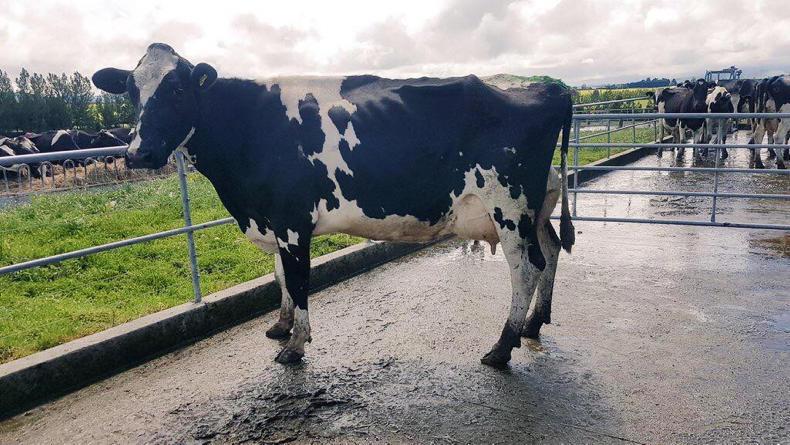
Black Jody the cow
She’s well fit to produce too. A pale white udder, perfectly shaped and comfortably holding the 52l and 3.3kg of solids she produces daily. I didn’t think it was possible to produce such yields from grass and only 2kg of meal.
Bruce told me Jody was a Canadian embryo transfer by Shottle, one of the UK’s greatest ever bulls. Her dam was a Canadian Winter Fair winner. Her son Jack, by Talent, now runs with the heifers in the herd. Hard to beat such a bull calf with any AI straw.
They also had straws made from him so he currently runs with the heifers and AIs the cows. Some bull.
Black Jody seems to be a favourite cow around the farm. She always gets two bales in the herringbone because she doesn’t fit otherwise.
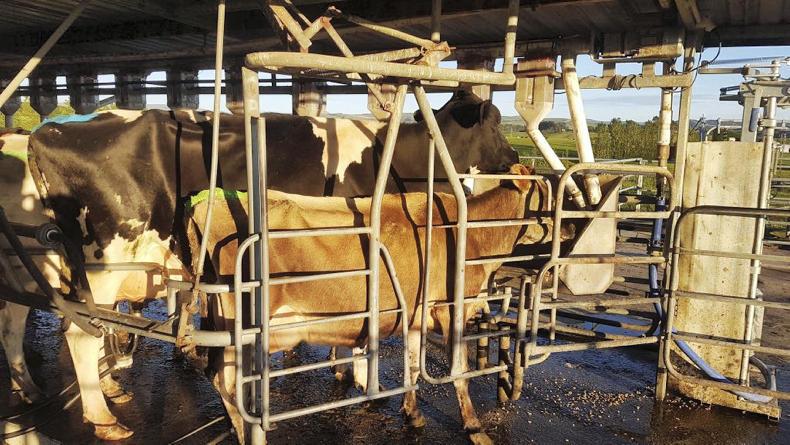
Black Jody’s sister, White Jody, is a more reserved cow. She doesn’t like all the attention and just milks away in the background.
Everyone knows the best cows by name on the farm. I reckon I’ve picked up on near 20 of them by now. Mothers and daughters often walk in together and cows definitely have their favourite sides to the herringbone.
Breeding
There’s always a chat in the shed about a cows’ breeding while we’re waiting for them to milk-out.
Red Holsteins are common in the herd and stand slightly taller than their red Ayrshire comrades. I enjoy listening and learning about how the red cows have been bred through the herd.
Some Holstein bulls carry the red gene and occasionally they spit out a red heifer calf. If a Red Holstein calf is mated to a Red Holstein bull the colour stays and Bruce begins to criss-cross between Dutch Red Holstein and Canadian Red Holstein sires.
The Dutch bulls produce all the milk in the world but in New Zealand udder strength is needed to carry the milk from pasture to parlour.
Bruce tells me he currently uses Canadian bulls for udder strength after Dutch bulls for milk yield. The criss-cross pattern is used over all the Holstein cows and gives a hybrid vigour of sorts for production and strength. UK and Irish genetics are used on the Ayrshire cows in the herd.
Classification
On the farm every year, all first-calvers are classified. Classification is a judging process which rates cows on 14 different traits such as height, legs, capacity, udder support, teat placement and rump angle.
A week after I arrived on the farm, all the Holstein first-calvers were classified by the New Zealand Holstein Friesian Association. The Ayrshires in the herd will be done next month by Ayrshire New Zealand.
After a week of rain and drizzle, Thursday morning came and the 110 cows drafted out for classification were brought in after milking. All the first-calvers along with some older cows were to be classified.
First-lactation cows can score up to "very good 89" (VG89) but must be re-classified after their fourth calf to be in with a chance of getting the sought-after "excellent" classification.
After an hour of judging, Black Jody walked on to the yard, the sun came out and she sparkled in the pen. Bruce took a photo before she even reached the classifier. We all knew she looked the part, so everyone was delighted when she got her first excellent classification.
“If you had to draw a perfect cow you couldn’t draw one better than her,” said Ken with delight. In New Zealand, cows can achieve their first excellent score at six years of age after four calves. In Ireland, excellent can be rated between EX90-EX99 but in New Zealand EX is the highest score and it can be awarded repeatedly.
Jody was soon followed by an old cow called Lana. She was already an EX cow and was awarded her second EX on the day – at 15 years of age after 12 calves. Some cow!
End of the season
We are now in the sixth week of the NZ breeding season. The beef bulls have been let out to the first herd of cows this week and AI will continue for another while on the second herd.
My own time in New Zealand is also drawing to a close. I’ve many thanks to give to all the Eades for their hospitality towards me. Thanks to Nancy I’ve yet to feel hunger since I landed and I get to enjoy a cup of tea and cake with the other workers, Craig and Amanda, during every milking.
With dry weather set to come for the next week we hope to get silage cut on the farm before I leave to go travelling the North Island with the rest of the UCD dairy business crew.
It’ll all start again when we head home in January and perhaps there’ll be a touch of New Zealand thinking in Nobber this year, but thanks to Fairleigh Ayrshires and Holsteins I know now it’ll all be possible without the crossbreds.
November is the last month of spring in New Zealand but there’s no sign of summer around the corner. After four months placement on a dairy farm in Canterbury, I drove five hours south to see another side of New Zealand dairy farming.
I arrived in West Otago in a pair of shorts on 14 October. On 15 October, I ditched the shorts for waterproofs and a rain jacket.
In the past week of bad weather, diversification into water buffalo and water cress farming has been discussed during milking on my new farm while the rain pounded off the tin sheets above our heads.
Combination
When you think about dairy farming in New Zealand, words such as winter milk, pedigree cows and cubicle sheds aren’t the first things that come to mind. It’s a rare combination to find over here but the power of social media helped me out.
Presenting myself as an “Irish dairy student missing the sight of Holsteins” on Twitter, I struck up conversation with Bruce Eade (@fairleigh_ag).
We knew nothing of each other but I soon discovered that Bruce had worked for a tillage farmer in Co Meath and had delivered a trailer load of cattle feed potatoes to my own farm at home back in 2001. It’s a small world!
Before I knew it, I was heading down State Highway 1 to start working on his farm. I realised just how far south I was when Bruce took me to a nearby hill top the first evening after milking and pointed out Invercargill and Bluff (next stop Antarctica).
The system
The farm here is a complete contrast to the Canterbury Plains. The rolling hills of Otago remind me of Nobber and the big milky Holsteins and Ayrshires are a pleasant sight in the paddocks. Ken and Nancy Eade are Bruce’s parents. They bought the farm here in 1995 and converted the 450ac block from a sheep farm to a dairy unit.
Originally, a 30-unit herringbone parlour was installed to milk 300 cows but as the herd and farm grew another 10 units were added to the pit to cope with the current herd of 510 cows.
Ken tells me of how in 1995 the farm produced 72,000kg of milk solids but now produces over 250,000kg of milk solids. One of the secrets to the increase in production on the farm has been accredited to the 520-cow cubicle shed built in 2012.
Housing
Previously dry cows had been grazed on kale over winter. Ken says they always survived the winter but never gained condition or thrived.
Bruce decided something had to change during a snowstorm in spring 2011. He was feeding out silage in a paddock white with snow, the wind picked up and he couldn’t find the gap back out of the paddock in the blizzard conditions.
A month later after looking at a handful of other cow barns, he sent a plan into the local council and ground work started midsummer. Concrete was poured soon after and steel began to arrive.

The cow barn which allowed the Eade's to start winter milking.
A 30t crane built all the steel in a day, the roofing was done a week later and the cows moved in on 25 May 2012, only six months after the idea’s conception.
Building the shed allowed the Eades to also begin winter milking. Empty cows no longer had to be culled or carried over dry for a year but instead could be milked on and calved in the autumn to produce winter milk.
In New Zealand, winter milk contracts are paid as a surplus on top of the normal milk price. Winter milk season runs from 1 June to 1 August with a bonus of up to $4.50/kgMS paid during the period.
The cows
I was driving up a gravel track to the address I’d been given for the farm, looking out for a sign saying #33420, the tanker track number. I met Bruce on the side of the road with two Alltech nutritionists looking out at the cows.
Bruce’s father Ken soon arrived and bet Rob McFarlane of Alltech a bottle of whiskey if the empty rate dropped below 10%.
The fun started there and soon after we headed straight to the parlour, a spotless clean 40-unit herringbone. The first few cows wandered in and rowed up lovely. Reds, blacks and browns.
The first cow I was introduced to was Black Jody. She’s a giant, standing three feet above the handful of Jerseys in the herd.

Black Jody the cow
She’s well fit to produce too. A pale white udder, perfectly shaped and comfortably holding the 52l and 3.3kg of solids she produces daily. I didn’t think it was possible to produce such yields from grass and only 2kg of meal.
Bruce told me Jody was a Canadian embryo transfer by Shottle, one of the UK’s greatest ever bulls. Her dam was a Canadian Winter Fair winner. Her son Jack, by Talent, now runs with the heifers in the herd. Hard to beat such a bull calf with any AI straw.
They also had straws made from him so he currently runs with the heifers and AIs the cows. Some bull.
Black Jody seems to be a favourite cow around the farm. She always gets two bales in the herringbone because she doesn’t fit otherwise.

Black Jody’s sister, White Jody, is a more reserved cow. She doesn’t like all the attention and just milks away in the background.
Everyone knows the best cows by name on the farm. I reckon I’ve picked up on near 20 of them by now. Mothers and daughters often walk in together and cows definitely have their favourite sides to the herringbone.
Breeding
There’s always a chat in the shed about a cows’ breeding while we’re waiting for them to milk-out.
Red Holsteins are common in the herd and stand slightly taller than their red Ayrshire comrades. I enjoy listening and learning about how the red cows have been bred through the herd.
Some Holstein bulls carry the red gene and occasionally they spit out a red heifer calf. If a Red Holstein calf is mated to a Red Holstein bull the colour stays and Bruce begins to criss-cross between Dutch Red Holstein and Canadian Red Holstein sires.
The Dutch bulls produce all the milk in the world but in New Zealand udder strength is needed to carry the milk from pasture to parlour.
Bruce tells me he currently uses Canadian bulls for udder strength after Dutch bulls for milk yield. The criss-cross pattern is used over all the Holstein cows and gives a hybrid vigour of sorts for production and strength. UK and Irish genetics are used on the Ayrshire cows in the herd.
Classification
On the farm every year, all first-calvers are classified. Classification is a judging process which rates cows on 14 different traits such as height, legs, capacity, udder support, teat placement and rump angle.
A week after I arrived on the farm, all the Holstein first-calvers were classified by the New Zealand Holstein Friesian Association. The Ayrshires in the herd will be done next month by Ayrshire New Zealand.
After a week of rain and drizzle, Thursday morning came and the 110 cows drafted out for classification were brought in after milking. All the first-calvers along with some older cows were to be classified.
First-lactation cows can score up to "very good 89" (VG89) but must be re-classified after their fourth calf to be in with a chance of getting the sought-after "excellent" classification.
After an hour of judging, Black Jody walked on to the yard, the sun came out and she sparkled in the pen. Bruce took a photo before she even reached the classifier. We all knew she looked the part, so everyone was delighted when she got her first excellent classification.
“If you had to draw a perfect cow you couldn’t draw one better than her,” said Ken with delight. In New Zealand, cows can achieve their first excellent score at six years of age after four calves. In Ireland, excellent can be rated between EX90-EX99 but in New Zealand EX is the highest score and it can be awarded repeatedly.
Jody was soon followed by an old cow called Lana. She was already an EX cow and was awarded her second EX on the day – at 15 years of age after 12 calves. Some cow!
End of the season
We are now in the sixth week of the NZ breeding season. The beef bulls have been let out to the first herd of cows this week and AI will continue for another while on the second herd.
My own time in New Zealand is also drawing to a close. I’ve many thanks to give to all the Eades for their hospitality towards me. Thanks to Nancy I’ve yet to feel hunger since I landed and I get to enjoy a cup of tea and cake with the other workers, Craig and Amanda, during every milking.
With dry weather set to come for the next week we hope to get silage cut on the farm before I leave to go travelling the North Island with the rest of the UCD dairy business crew.
It’ll all start again when we head home in January and perhaps there’ll be a touch of New Zealand thinking in Nobber this year, but thanks to Fairleigh Ayrshires and Holsteins I know now it’ll all be possible without the crossbreds.









 This is a subscriber-only article
This is a subscriber-only article












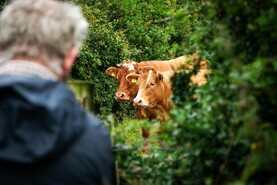
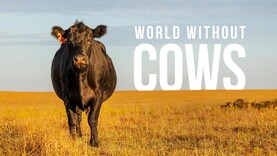
SHARING OPTIONS: